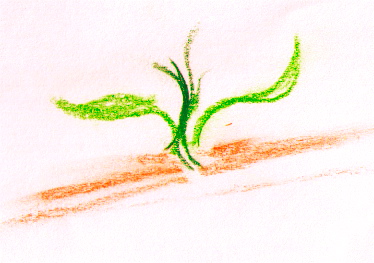I was a participant in my second year in atria One as teacher trainer. During the course of the year I was aware of a persistent fear. The experience of fear never really left me. I struggled to put words on my experiences, they did not feel right, forced. When I did try to force words, I lost my experience, so I stopped. I was quiet. I listened and felt what was within. I stayed there and didn’t try and force words to come.
In looking through my images and notes from that year a theme arise, the fear of being alone and the experience of emptiness. I try to cover the fear or to fill the emptiness with people; with my father, who is now dead and with my husband, whose presence no longer softens my experience of fear and whom I felt distance from for the first time. In a drawing of Jeff and myself (Image 1&2) the lines of each figure go past each other; together physically, but distant.
The early memory drawings (Images 3&4) brought me back to my experience of my father, of his warmth and my connection with him. My father continued to be present in the body poem experiment. I first attend my father—where I held my experience of him in my body, in my chest. As I attend him my awareness shifted to Jeff. I became sad. As I attended my experience of Jeff and looked within the image of a circle hanging on a curved line appeared (image 5). I am hanging. I did not know where our relationship would lead. I had to stay with just myself, to know myself without another.
The process of knowing myself without the other was experienced in the homework assignment, beyond the point of boredom. I drew blue lines of many kinds, over and over again on many sheets of paper until I was bored. I pushed myself to continue. My last drawing was one small blue dash on a single piece of paper (image 6).
Taking away, reducing, leaving only what is necessary. Stay with one—single—what is. I held a piece of clay with my eyes closed. I tore a piece of the clay off and put it aside. I rolled the remaining clay into a ball. It felt too big. I tore more clay off and formed the clay in my hands into a smaller and yet smaller ball. At the end there was almost nothing there. What remained was a very tiny ball between my thumb and forefinger.
My experience of myself and of being alone began to shift in my images. First a single black line became present (image 7) “I am alone. Black line. Almost touching myself.” The “almost touching” statement settles me. The image of a flower (image 8) is similar, “A line coming up from the bottom—a ‘coming out’ in a sense. An openness. A presence. I am settled, resting, held, between, one, lone, single. I am here, present”.
The chasm drawing series illustrates the shift from fear of being alone to an acceptance, a “settling into” myself. The assignment was to draw how I would get to the other side of the chasm. I drew myself in mid air, between to large pointed black and brown hills (image 9). The experience is of being suspended—fearful. The second drawing was of a single black hill with a split through it. A black circle (me) is falling into the split (image 10). In the next drawings there is a movement to a resting place or an opening to what is present within—an emerging. The black circle is resting at the bottom (image 11). Out of the black circle a flower grows, emerges (Image 12).
At this point in my process I was not aware of the shift taking place. The change showed in my images. I remember experiencing a settling feeling response to images 13 and 14, though I could not put words to what was happening. I remember quietly attending myself and not feeling as overwhelmed by the fear as I had the year before. My experience of this year echoes the experience stage in the Creativity Continuum. McNeil writes on page 13:
The function of the experience or incubation stage is separating which requires more passive mode of participation. It is, ideally. A quiet accepting, relinquishment of conscious control that allows the process to continue mostly outside of awareness. In our impatience to proceed we may be tempted to manufacture an ‘appropriate’ experience in order to avoid having to wait and practice patience.
The separating function of the experience stage results from leaving the morass of chaos for the clarity of a single feeling or sense experience. This description is admittedly cryptic and ideal, nevertheless, it happens, if only in increments, which cannot always, because of their minuteness, be identified.
Last year, in my first year in Atira One as teacher trainer, I learned to embrace the experience of chaos. The shift to the experience stage of the creativity continuum is a natural progression. There is an experience of separation. Sort of like being a passive observer—of life, of yourself. Yet at the same time being more fully aware, more fully feeling. Quiet acceptance of what is presented rather than an active embracing. Not involvement in the world—passively watching. An act of trust, willing you to be, willing you to see, who you already are.
REFERENCE:
McNeil, Evadne (1996). The Creativity Continuum. Baileys Harbor, WI: Atira Publications.
